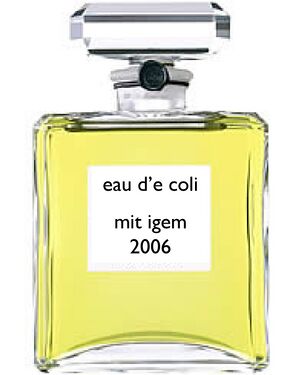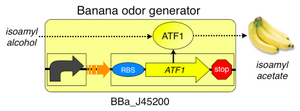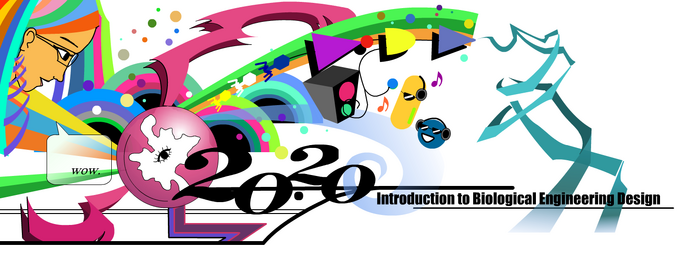2020(S13) Lecture:week 1
Week 1 Tuesday
Got DNA?
After a short introduction to the who/what/why for this class, we'll start handling the programming material that's at our fingertips...in our fingertips, even! As you work through this DNA isolation protocol below, be mindful of your questions and your own reactions to this activity. Is this the first time you've ever handled a lump of DNA? How hard is it to isolate DNA, both technically speaking and in terms of the needed equipment? What surprised you? What did you learn and what questions do you still have? What could you do next with this material you've isolated?
DNA from a Strawberry
- Pair up and pick up a ziplock baggie with a strawberry in it. IF YOU ARE ALLERGIC TO STRAWBERRIES, please don't do this part.
- Push the air out of the baggie as best you can and reseal it.
- Being careful not to break the baggie, mash the strawberry with your fingers for ~2 minutes.
- Using a medicine cup or conical tube to measure, add 10 ml of extraction buffer to the baggie. Extraction buffer is a mixture of 10 ml dish soap, 1 tsp of table salt, a sprinkle of meat tenderizer, and 200 ml of spring water.
- Mash the strawberry for one minute more.
- Place a funnel over a small cup or 50 ml tube.
- Fold a piece of cheesecloth into a ~4 inch square and place it in the funnel.
- Pour the strawberry mush into the funnel and allow gravity to do its work. You'll throw away the strawberry mush and cheesecloth into the trash, and return the funnel to the kit.
- Carefully pour 2 ml of the filtered strawberry juice into a clean, 15 ml conical tube, using the markings on the side of the tube to know how much to transfer.
- Hold the tube at an angle and, using an eye-dropper, carefully DRIBBLE a 5 ml layer of cold 95% Ethanol or 70% isopropanol (your choice) onto the strawberry goop. DO NOT MIX the layers.
- Now watch...after a few minutes you should start to see some bubbles, then some white stringy stuff, which is the DNA.
- There will be coffee stirrers to remove the DNA from the tube if you'd like to do that. The DNA is best removed by "spooling"--i.e. winding the DNA around the stick with a gentle twirl of stick.
|
Let's return to the questions from the start of the day:
|
Week 1 Studio
Wednesday matinee
Instructions: Today you will have the opportunity to watch a video showcasing completed iGEM projects. "iGEM" stands for the "international Genetically Engineered Machines" competition. It is a summer-long opportunity for teams of students working at colleges and universities around the world to design and build genetically engineered machines, many of which use standard biological parts from the Registry of Standard Biological Parts. The video will orient you to the kinds of accomplishments realized in a summer by teams of undergraduates and their advisers.
Our feature presentation

- the 2006 iGEM team from MIT describing a neat project for fine chemical synthesis presentation video presentation ppt
Their project will allow us to focus on
- programming genetic logic, growth phases of bacterial cultures
- our review slides are here
- our review slides are here
- programming genetic logic, growth phases of bacterial cultures
After the presentation
You will have 10 minutes to gather with your fellow moviegoers and discuss what you saw, using these "iGEM review questions" as a guide for your conversations:
- what was the problem this team chose to address and why?
- is this an important problem and why or why not?
- did they succeed in part or in total?
- are there aspects of the work that are unclear to you?
- if you could ask this team one question what would it be?
Our second feature
There have been many wonderful projects from teams over the years, but to narrow down the number of possible choices, let's look at the projects from recent MIT teams. As a class we'll choose one of the following videos to watch and discuss:
- MIT 2008: Biogurt, fighting tooth decay since 2008,presentation video
- MIT 2009: Phycocyanobilibuddies, photolocalizer project,presentation video
- MIT 2010:Programmable, self-constructing biomaterials, presentation video
- MIT 2011: Tissue by design, presentation video
- MIT 2012: RNA strand displacement for sensing, presentation video
After the presentation
Take time again with your fellow movie goers to discuss what you saw
- what was the problem this team chose to address and why?
- is this an important problem and why or why not?
- did they succeed in part or in total?
- are there aspects of the work that are unclear to you?
- if you could ask this team one question what would it be?
After the show
Before you leave today, consider the topic areas that are prized by iGEM judges. In 2012, prize areas were:
| Area | Challenge |
| Food or Energy | People need to eat. Planes, trains, and automobiles need to eat too. Can biotechnology be responsibly used to produce food or energy without causing widespread shortages of either, and without harming the environment that future generations will inherit? |
| Environment | The quality of the air, water, and land, both on Earth and other heavenly bodies, limits the happiness of humans and other creatures. Can biotechnology be used to help clean the air, provide fresh drinking water, restore or enhance soil quality, terraform a near-Earth asteroid, or protect, preserve, or enhance natural biological diversity? |
| Health or Medicine | Many health and medical problems might best be addressed by improved biological technologies. What can synthetic biology do? |
| Manufacturing | Have you ever heard of nanotechnology? Well, biology is a nanotechnology that already exists, and that actually works. The ribosome is a programmable nanoassembler embedded within a reproducing machine. Could we responsibly use biology to manufacture useful products, from the nanoscale (atoms) to the decascale (buildings and bridges). What can biology be programmed to manufacture? |
| New Application Area | We're guessing that you have great ideas that nobody has ever thought about, or if they have they forgot to tell somebody else. Can you imagine an entirely new application area for biological technology? |
| Foundational Advance | Just thirty-five years ago, scientists could not cut and paste pre-existing fragments of genetic material like we can today. The discovery and application of DNA recombination allowed us to assemble new genes. The synthetic biology community needs other enabling technologies that help to make new accomplishments possible. What other types of basic tricks does nature use? Have you discovered and applied one that could revolutionize synthetic biology? |
| Information Processing | The diversity and abundance of biological properties, behaviors and parts presents a huge information processing challenge. Has your project led to an innovative system that allows us to navigate and use lots of information quickly and effectively? |
BEFORE YOU LEAVE TODAY
Put your name on a piece of paper or index card and list your top 3 areas of interest. Hand in this list before you leave.
This term you'll be on a team of 20.020 students and work with 20.385 mentors to design and specify an iGEM-like system in one of these areas. You won't get to build it unless you sign on for the iGEM summer, but many 20.020 students have gone on to do just that...
|
Next time we will work with the banana-smell generating system. In advance of this activity, please
|
Week 1 Thursday
Eau that smell!
Today you will compare 2 competing designs that are based on the Eau d'coli project you learned about last time.

Acknowledgments: A longer version of this activity is housed at BioBuilder.org. It was developed with materials and guidance from the MIT 2006 iGEM team, as well as technical insights and help from Ginkgo Bioworks
Procedure
- As a warm up, we'll have a short presentation from MIT' EHS. This will cover basic biosafety and help us prepare for the hands-on activity.
- Begin by reviewing BioPrimer 1. Is it clear the differences are between the 4 strains of bacteria well be studying?
- Next we'll watch the animation about cell growth and division. Is it clear how log, lag, and stationary phase differ? Is it clear how you'd know what phase of growth the cells are in?
- Finally, you'll work in small groups to compare the turbidity and the banana-smell intensity for the four strains at each stage of growth. Give each strain a smell value and a density value.
- When you are done collecting your data, please wash your hands.
- Next, upload your data to the BioBuilder website, login as "natbioethics"
- Before you leave today, we'll consider these questions:
- Were we able to measure the population growth?
- Were we able to smell bananas?
- Did each device produce the same results?
- Did the genetic systems affect the growth curve of the bacteria? Explain your answers.
- How confident are you in the results?
- Are you equally confident in both the growth data and the smell data?
- Is using smell to measure the banana smell valid? Why or why not?
- What methods did you use to try to increase your confidence in the results?
- How might we try to change this system so that we can quantify the banana smell? Would we be better off using a different kind of signal? If so, what would you suggest?
- If you could construct a different genetic system, what might you construct? What would you need to do?
|
You've now had some first hand experience with an engineered biological system. We'll return to this experiment a number of times during the term for different reasons but it's hoped that this first week has given you a taste (not literally!) of the kinds of creative solutions that are possible in biological engineering design. |
